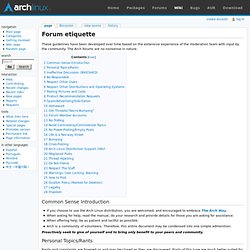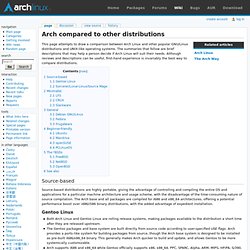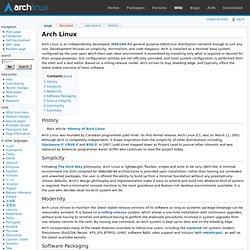

Main Page. FAQ. Beginners' Guide. This document will guide you through the process of installing Arch Linux using the Arch Install Scripts. Before installing, you are advised to skim over the FAQ. The community-maintained ArchWiki is the primary resource that should be consulted if issues arise. The IRC channel ( and the forums are also excellent resources if an answer cannot be found elsewhere. In accordance with the Arch Way, you are encouraged to type man command to read the man page of any command you are unfamiliar with. Preparation. Forum Etiquette. These guidelines have been developed over time based on the extensive experience of the moderation team with input by the community.

The Arch forums are no-nonsense in nature. Common Sense Introduction If you choose to use the Arch Linux distribution, you are welcomed, and encouraged to embrace The Arch Way. When asking for help, read the manual, do your research and provide details for those you are asking for assistance. When offering help, be as patient and tactful as possible. Proactively seek to give of yourself and to bring only benefit to your peers and community. Personal Topics/Rants Rants and complaints are frowned on and may be closed as they are discovered. Ineffective Discussion (BIKESHED) Threads stating the equivalent of "there is a problem with the Arch system and methodology, we need to discuss it" have been repeatedly proven ineffective and inflammatory and will usually be locked after a warning from the moderation team. Be Responsible Respect Other Users Homework Bumping.
Getting Involved. This article describes how both new and experienced Arch users can contribute to the community. Note that this is not an exhaustive list. Official Arch Linux projects Post on the forums One of the easiest ways to get involved is participating in the Arch Linux Forums, which allow getting to know the community and help new users. Please get accustomed with Forum etiquette. Improve this wiki. Arch Compared to Other Distributions. This page attempts to draw a comparison between Arch Linux and other popular GNU/Linux distributions and UNIX-like operating systems.

The summaries that follow are brief descriptions that may help a person decide if Arch Linux will suit their needs. Although reviews and descriptions can be useful, first-hand experience is invariably the best way to compare distributions. Source-based Source-based distributions are highly portable, giving the advantage of controlling and compiling the entire OS and applications for a particular machine architecture and usage scheme, with the disadvantage of the time-consuming nature of source compilation. The Arch base and all packages are compiled for i686 and x86_64 architectures, offering a potential performance boost over i486/i586 binary distributions, with the added advantage of expedient installation. Gentoo Linux Sorcerer/Lunar-Linux/Source Mage Minimalist. The Arch Way. This page is intended to be a page to demystify common terms used among the Arch Linux community.

Feel free to add or modify any terms, but please use that particular section's edit option. If you decide to add one, please put it in alphabetical order. The Arch Build System (ABS) is useful to: Make new packages of software for which no packages are yet available Customize/modify existing packages to fit your needs (enabling or disabling options) Re-build your entire system using your compiler flags, "a la Gentoo" Getting kernel modules working with your custom kernel. Arch Linux. History Main article: History of Arch Linux Arch Linux was founded by Canadian programmer Judd Vinet.

Its first formal release, Arch Linux 0.1, was on March 11, 2002. Although Arch is completely independent, it draws inspiration from the simplicity of other distributions including Slackware, CRUX and BSD. In 2007, Judd Vinet stepped down as Project Lead to pursue other interests and was replaced by American programmer Aaron Griffin who continues to lead the project today. Simplicity Following The Arch Way philosophy, Arch Linux is lightweight, flexible, simple and aims to be very UNIX-like. Modernity Arch Linux strives to maintain the latest stable release versions of its software as long as systemic package breakage can be reasonably avoided. Software Packaging Arch is backed by pacman, an easy-to-use binary package manager that allows you to upgrade your entire system with one command. Source Integrity Community Summary. Official Arch Linux Install Guide. This document is a guide for installing Arch Linux from the live system booted with the official installation image.

For alternative means of installation, see Category:Installation process. Before installing, it would be advised to view the FAQ. For conventions used in this document, see Help:Reading. In particular, code examples may contain placeholders (formatted in italics) that must be replaced manually. For more detailed instructions, see the respective ArchWiki articles or the various programs' man pages, both linked from this guide.
Arch Linux should run on any x86_64-compatible machine with a minimum of 530 MiB RAM. Pre-installation The installation media and their GnuPG signatures can be acquired from the Download page. Verify signature It is recommended to verify the image signature before use, especially when downloading from an HTTP mirror, where downloads are generally prone to be intercepted to serve malicious images. $ pacman-key -v archlinux-version-x86_64.iso.sig # fdisk -l.